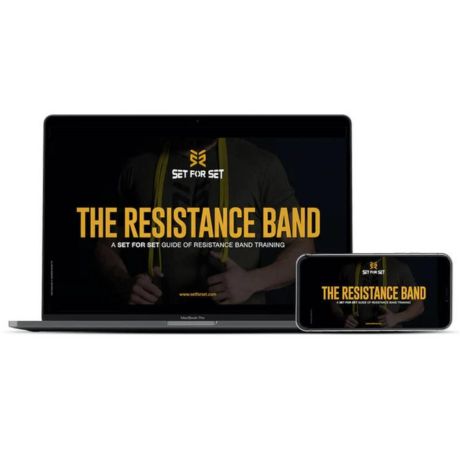There are many different types of resistance bands on the market, but as with many things in life, not all were created equally.
Not only do you have to consider the different kinds of resistance bands, but also the resistance levels, quality of materials used, and price points.
Take Your Fitness To The Next Level
After many years of resistance band training, we believe that we can provide you with the best information on this subject, and that's what this article is meant to do.

Our guide has over 250 exercises categorized by mobility, mobilization, resistance training, barbell training, explosive training, static stretching, and (p)rehabilitation...
Table of Contents:
- The 5 main types of resistance bands
- Comparison table of the different types of exercise bands
- What type of resistance band is best?
- Resources & FAQs
5 Types of Resistance Bands (Plus: Sizes & Benefits)
First we will go over the 5 different types of bands and the finer details of how they are used and the benefits of using them. After, we will go over which is best.
1. Loop Resistance Bands (aka Power Resistance Bands)

Power resistance loop bands are essentially like massive rubber bands. They are a continuous flat loop that can be used for a variety of purposes.
You can use loop bands for bodyweight assistance (pull ups, dips, muscle ups, etc.), bodyweight resistance (push ups, bear crawls, box jumps), full body workouts (squats, shoulder presses, thrusters, etc.), physical therapy (people suffering from leg, knee and back injuries and help in recovery from torn MCL and ACL, knee replacement, patella and meniscus rehab), warm ups, static stretching (increased the stretch and new stretching positions you’d otherwise have trouble getting into), and you can couple them with free weights for added resistance (squats with bands, bench press with bands, etc.).
Furthermore, you can anchor them to a pole/bar for pulling and pushing exercises and rehabilitation exercises (i.e. rotator cuff).
All in all, they are super versatile, allowing you to work through all three planes of motions, and power loop bands can be used for every aspect of strength training, whether it’s athletic focused or bodybuilding focused.
Sizes/Resistance:
Power resistance bands (aka pull up band, aka loop band) are all 41 inches in length and 0.18 inches in thickness. The differences between the sizes is the width of the band. The width determines the level of resistance.
The width of the bands range from 0.25 to 2.5 inches. So, if you had all the different sizes, you'd have roughly 5-175lbs of resistance.
For reference, here are general loop resistance band sizes and resistance levels:
-
(1/2"): 5 to 30 Pounds (41" x 0.5" x 0.18")
-
(7/8"): 20 to 55 Pounds (41" x 0.85" x 0.18")
-
(1 1/4"): 35 to 70 Pounds (41" x 1.25" x 0.18")
-
(1 3/4"): 45 to 115 Pounds (41" x 1.75" x 0.18")
- (2 1/2"): 60 to 170 Pounds (41" x 2.5" x 0.18")
Benefits of Loop Bands:
- Dip & Pull up assistance
- Hypertrophy
- Muscle endurance
- Explosiveness
- Muscle strength
- Balance and Coordination
- Stability
- Losing fat
- Flexibility
- Mobility and Increased Range of Motion
- Rehabilitation
- Low impact on joints
- Multiplanar exercises and unilateral movement

Perfect for all strength levels. Workout bands can be added to increase your performance on deadlift, bench press, squat, shoulder press...
2. Resistance Band Tubes with Handles

Tube resistance bands have handles that attach to both ends and they are made to mimic gym machine and dumbbell exercises. Tube bands easily anchor to the door or a bar/pole.
They are good for chest presses, curls, back rows, shoulder presses and other exercises that involve pressing and pulling. A tube band will also be good for programs like P90X.
It’s possible to hit all of your muscle groups with tube resistance bands so they are great for those who don’t have access to a gym or those who like to train outdoors and they want something simple and easily portable.
Sizes/Resistance:
On average, sets of tube bands will offer 10-50 pounds of resistance. The thickness of the tubes determines the resistance.
Benefits of tube resistance bands:
- Muscle strength
- Hypertrophy
- Muscle endurance
- Improve Range of Motion
- Burning fat
- Rehabilitation
- Low impact on joints

Lightweight and portable, use anytime and anywhere: The resistance bands are ultra lightweight and easy to carry. You can easily pack them...
3. Rubber Mini-Bands & Fabric Non-Slip Hip Circle Bands

Mini bands are like Power Resistance Loop Bands but much shorter and wider. New designs come with a fabric covering the bands for added comfort and to stop the band from rolling up, which is a common occurrence with the very light resistance mini bands (we much prefer the non-slip fabric bands).
Mini hip bands can be used for increasing strength and stability in your lower body (and upper body with certain exercises).
By placing them just above your knees or at your ankles, you can get great hip and glute activation. They are also good to use while weight training. Mini bands can help you stabilize, activate your core, maintain proper form, and get that extra activation and tension in the hips during lifts like squats, hip thrusts and leg extensions.
As with most resistance bands, mini bands can target shoulder complexes effectively as well, and they are a good tool for shoulder and elbow stabilization.
If you are into calisthenics, mini bands work well to prime correct form for movements like handstands and muscle ups.
Essentially anyone who goes to the gym these days will see mini bands being used in a variety of ways. This is proof of their effectiveness and versatility.
Sizes/Resistance:
Sets of mini bands are usually stated as light, medium, heavy, and extra heavy. This should be approximately 5-50+ pounds of resistance.
These bands will vary in length and thickness depending on their resistance, but they are all made to wrap around the legs.
Benefits of mini bands:
- Warm ups
- Toning & booty band workouts
- Hip and glute activation
- Maintaining and priming proper form
- Muscle strength and endurance
- Stability
- Low impact on joints
- Rehabilitation

The optimal choice for a low-impact highly efficient training tool to enhance your lower body performance. Our non-slip booty bands are an awesome addition...
4. Light Therapy Resistance Bands

Therapy bands are very long (up to 7 feet) and thin, light 'free bands', meaning they do not loop (although you could tie them in a knot to create a loop).
Physical therapy resistance bands are made for people who are regaining strength after an injury and elderly people who want a very low impact workout routine.
They are also effective when combined with Pilates and fat burner workouts, where all you need is a little added resistance to get a really good burn. Many women use light therapy bands in this way for muscle toning.
Another way to use them is during warm ups for dynamic stretching and static stretching at the end of a workout. These types of bands can help you increase the stretch and improve mobility/range of motion.
Sizes/Resistance:
On average, sets of therapy bands will offer 3-10 pounds of resistance.
Benefits of therapy resistance bands:
- Physical therapy and rehabilitation
- Weight loss
- Muscle toning
- Muscle strengthening (for beginners or people with muscle weakness)
- Flexibility

A superior band product for resistance training and rehabilitation, provides both positive and negative force on muscles and joints...
5. Figure 8 Bands

Figure 8 bands are shaped exactly as the name suggests. They have soft handles at the top and bottom of the figure 8 shape. They stretch as far as you’d need them to, to be able to target both your upper and lower body. Figure 8 bands can be used similarly to mini bands for lateral movements, and similarly to tube resistance bands to mimic machine and dumbbell exercises. They are best used for pushing and pulling exercises in the sagittal and lateral plane of motion.
Sizes/Resistance:
On average, sets of figure 8 bands will offer 8-20 pounds of resistance.
Benefits of figure 8 bands:
- Physical therapy and rehabilitation
- Weight loss
- Muscle toning
- Muscle strengthening
- Muscle endurance
- Stability through unilateral movements.

Our figure 8 tubes resistance bands are made of 100% natural latex and come in 3 resistance levels, from light (8-10LB) to medium (13-15LB) to heavy (17-20LB)...
Comparison Table of Resistance Band Types:
| Type of Workout Band: | Main Uses: |
| 41" Loop Resistance Band | Resistance training, combine with weights, mobility, stretching, warm up, muscle activation, rehab |
| Tube Resistance Band with Handles | Resistance training, muscle activation |
| Mini Band | Lower body resistance and activation |
| Therapy Band | Rehab, very light resistance training |
| Figure 8 Band | Upper body resistance and activation |
What Is The Best Type of Exercise Band & Why?
The best type of resistance bands is the 41" Power Resistance Bands (Loop Bands).
They are the most durable, and they are surely the most versatile in terms of uses and resistance level.
Below we will provide you some resources of ours so you can see many ways loop resistance bands can be used...
Targeted Resistance Band Exercises & Workouts:
- Resistance Band Chest Exercises
- Resistance Band Back Exercises
- Resistance Band Shoulder Exercises
- Resistance Band Leg Exercises
- Resistance Band Tricep Exercises
- Resistance Band Bicep Exercises
- Resistance Band Core & Ab Exercises
- Resistance Band Deadlift Variations
- Resistance Band Squat Variations
- Resistance Band Push Up Variations
- 24 Best Resistance Band Exercises for Full Body & Each Muscle Group
- Full body resistance band and bodyweight workout

The SFS FIVE Resistance Band Workout Package has 5 fun and challenging full length workouts using only resistance bands. Each workout targets different muscle groups. Together, the 5 workouts make for the perfect weekly workout routine.
Mobility & Stretches Exercises with Bands:
- How to stretch with bands
- Mobility Exercises with Bands
- Hip Mobilization with Bands
- Leg Stretches with Bands
- Resistance Band Ankle Mobility Exercises
Rehab Exercises with Bands:
Pair Bands with Free Weights:
- Bands paired with kettlebells and steel maces
- Bands paired with barbells
- Chest exercises with bands at the gym
More Resources:
- How to build muscle with resistance bands
- How to lose weight with resistance bands
- 10 ways to use resistance bands to improve your fitness
- Boost Athleticism With Bands
- Explosive Exercises with Bands

Power Loop Resistance Bands vs The Other Bands
The main reason power resistance bands are best is because they can be used in all of the same ways as the other bands plus way more. It's as simple as that. Moreover, they do so in a more effective manner for most uses.
However, there are some slight exceptions...
In regards to booty bands, these bands have their own speciality uses for the glutes and hips (i.e. glute specific exercises and squatting with the hip bands around your legs for more glute activation).
That being said, for glute specific exercises, you can strap power bands to an anchor or pole to get those lateral hip movements in to similar effect as a mini band, as seen in this video...
As for not having handles, if you want to add handles or an ankle strap to power resistance bands, all you need is a carabiner clip. In fact, you can tie them up without the clip as well.
All in all, 41" power resistance bands can be used in all aspects of your training. It’s definitely worth buying a set. They will be the greatest non-consumable asset in your workout bag and you can take them anywhere and everywhere (gym, park, vacations).
In addition to power resistance bands, fabric booty bands would be great to have as well. These mini loop bands are our second favorite type of resistance band.
Related: Resistance Tubes with Handles vs 41" Loop Resistance Bands
Loop Band Resistance Levels
A single band will offer resistance in varying amounts. For example, a small band may range from 5-15lbs of resistance. It all depends on how you hold or anchor the band.
- (1/4"): 5 to 20 Pounds (41" x 0.25" x 0.18")
-
(1/2"): 5 to 30 Pounds (41" x 0.5" x 0.18")
-
(7/8"): 20 to 55 Pounds (41" x 0.85" x 0.18")
-
(1 1/4"): 35 to 70 Pounds (41" x 1.25" x 0.18")
-
(1 3/4"): 45 to 115 Pounds (41" x 1.75" x 0.18")
- (2 1/2"): 60 to 170 Pounds (41" x 2.5" x 0.18")
Related: What size resistance band should I buy?
Quality of Resistance Bands
You want bands that have continuous layering. The process of manufacturing bands with continuous layers aids in preventing any type of breakage or tearing for long term usage.
Continuous layering makes the bands extremely durable and last a long time. Furthermore, because of the high-quality latex and the manufacturing process, these resistance bands can stretch up to 2 ½ times their original size.
If you have any questions, please don’t hesitate to shoot us an email at support@setforset.com

Our 41" latex fitness bands are made with quality and comfort in mind. Made of natural rubber latex - 99.998% free of soluble proteins - they can stretch up to...





1 comment
What is the best type of band to use for face pulls?